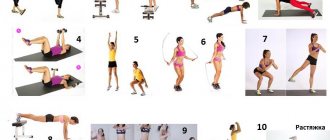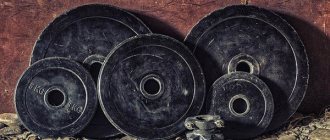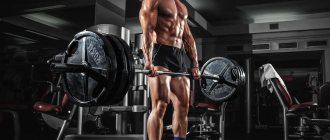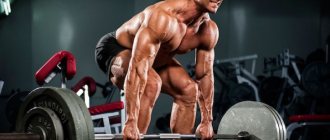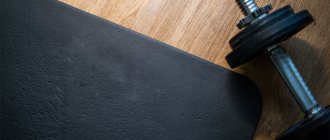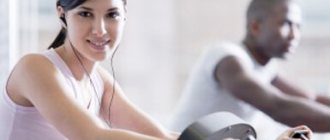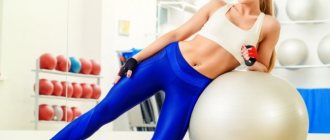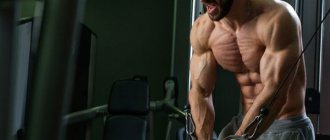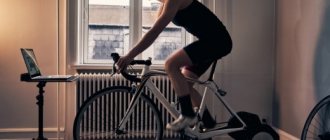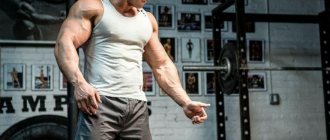Quite often, experienced athletes begin to notice how some muscle groups respond to the load better, while others, on the contrary, begin to lag behind in development. Why is this happening? Maybe you have trouble feeling the working muscle; you give it insufficient load for growth or, on the contrary, you do too many exercises, so that the muscle does not have time to recover...
In any case, we are for a harmonious physique, and therefore today we will talk about how to pump up the outer part of the thigh - exactly the same area that is often left without due attention. And very much in vain!
Legs need to be worked hard and intensively, devoting a lot of time and effort to them, and beginners, understandably, want to quickly get voluminous arms; they often don’t even think about their legs. That’s why it’s not surprising that this is the lagging muscle group for most gym goers...
Indeed, it is easier to do a couple of sets for biceps than to put a heavy barbell on your shoulders and squat with it. However, if you don’t want to turn into a laughing stock on the beach, carrying a powerful torso on two noodles, then it’s time to take your legs in hand and pay more attention to your quadriceps.
Briefly about the structure and functions
To understand how to pump up your thighs, you first need to understand the muscle structure and functions they perform.
There are four main groups:
- Quadriceps
They are also the front surface of the thigh, the largest and strongest muscle, when training which the heaviest weights are used.
Consists of four muscle heads - rectus, intermediate, lateral and medial.
As a rule, quadriceps are well developed in both men and women. This part of the body has minimal subcutaneous fat content.
The quadriceps straightens the leg at the knee joint from different starting positions.
The main exercises where the anterior surface of the thigh is maximally loaded are knee-dominant, that is, all variants of squats and lunges.
It also uses an isolated movement - leg extension while sitting on a block.
- Biceps hamstrings
The back surface of the thigh is also an antagonist of the quadriceps, that is, it performs the opposite function - bending the leg at the knee and helping to straighten the torso.
Second in strength and size. Consists of the medial and lateral heads, as well as smaller semitendinosus and semimembranosus.
Since in everyday life the back surface is used much less than the quadriceps, this gradually leads to the accumulation of excess fat in this area and the formation of cellulite.
Involved in all pelvic-dominant movements, which we will talk about a little later.
- Inner surface
Or simply - leading. Here we distinguish between the long, short and magnus adductor muscles, as well as the pectineus and gracilis.
This is a relatively weak group, which can be especially problematic for girls.
Low tone of the adductors, combined with fat deposition in this area, often leads to sagging skin and worsens the aesthetics of the body.
These muscles help bring your legs together. They are trained with larger leg sections or through isolation movements with light weights.
- External surface
It is represented by one muscle - the external tensor fascia lata.
This is a small and relatively weak muscle that works inextricably in conjunction with other, stronger ones - the gluteal and lateral heads.
This is another problem area specific to women. Due to anatomical and physiological characteristics, girls have a tendency to accumulate excess fat in this part.
The main function of the external tensor fascia is to abduct the leg to the side. And he often trains with an exercise with the same name.
Useful tips
- The gluteal muscle needs a strong contraction for its fibers to begin active growth. To do this, you need to raise your knee as high as possible in the starting position, and then hold it there during extensions.
- At the lowest point of the amplitude, it is important not only to keep the knee suspended, but also to bring it slightly closer to the chest. This will further shrink the buttocks.
- To increase the effectiveness of the exercise, weights or just heavy boots are put on the lower leg. With their help, the buttocks will be worked out even better.
- It is recommended to perform a minimum of 20 repetitions over 3-4 sets.
- You can linger at the top point of the amplitude, but only for one second, since holding the knee for a long time will relax the muscle.
A properly made protein shake can build muscle in no time!
Learn how to perform barbell wrist curls here.
And if you are interested in wide-grip push-ups from a bench, then this is for you - /silovye/s-grud/otzhimaniya-shirokim-hvatom-ot-lavki.html.
Basic and isolation exercises
In bodybuilding, it is customary to divide all exercises into two large groups. These are basic multi-joint movements and isolating single-joint ones.
The basic ones involve two or more joints, as well as a large number of muscle groups.
A striking representative of such a movement will be lunges. Three joints work here at once - the hip, knee and ankle. As well as hamstrings, quadriceps, calves, buttocks, lumbar and abs.
The big advantage of the base is that it can often be performed even without equipment. This means that these hip exercises are suitable even for training at home.
Isolating movements include movements in which only one joint and a small number of muscles work.
For example, bringing your legs together in a simulator. Here only the hip joint is involved, and the main load falls on the inner surface.
When drawing up training programs for pumping the legs, the selection of exercises is primarily taking into account this characteristic.
The base is more designed for comprehensive leg work, stimulating muscle growth and strength levels.
While isolation has little effect on growth, it is good for targeting a specific muscle.
Therefore, such exercises are indispensable when working on relief or when tightening lagging areas of the legs.
Leg raises while sitting in the simulator.
To pump up the outer thigh to failure at the end of the workout, we will work on it in isolation.
Execution: sit in the exercise machine, rest your feet on the holder pillows. Overcoming resistance, spread your legs to the sides along the maximum accessible path. Then smoothly return to the starting position... Do 3-4 sets of 10-15 repetitions, and your quadriceps will begin to “burn with fire”...
Legs are the foundation of a strong body. Follow our recommendations, and within a month you will amaze your friends with the power of your lower half. See you on the platform!
- < Back
Exercises to train the hamstrings
The back of the thigh works actively in the following movements:
- Romanian deadlift
Performing with a barbell, dumbbells or kettlebell is suitable here.
- Deadlift
It's also a deadlift with straight legs. Here the hamstrings are involved even more actively than in the previous exercise.
- Bent-overs with a barbell on your shoulders
An option that is as close as possible to the Romanian deadlift, but here the bar is located on the shoulders.
All of the above exercises are also performed on one leg.
If we talk about isolating movements, then moving the leg back in a crossover, or with weights, is suitable here. It is also performed on all fours, with the knee bent or straight.
The most common exercise is leg curls in a lying or sitting machine.
Often, along with the hamstrings, the gluteal muscles are actively loaded.
Leg extensions from a sitting position.
Execution: we extend not both legs, but each separately. If the design allows, we sit on the machine diagonally, hanging the free leg to the side of the seat. The working leg is slightly “rolled” inward, which will allow you to concentrate on the outer surface of the thigh. We do 15-20 repetitions and change legs.
In addition to pre-exhaustion, extensions at the beginning of the workout are also a good warm-up for your knees, after which you can move on to the “main dish” - squats.
Recommendations for training
In general, men and women have different goals when training their leg muscles. This means that the approach and set of exercises will be different.
For men
When exercising, strength training is used to increase muscle volume and strength.
The basis of the classes are basic exercises - squats, leg presses and lunges. The proportion of isolation exercises during this period is small.
As a rule, only flexion and extension of the legs in the simulator are used.
Training frequency – 1-2 times a week.
It is often practiced to train the quadriceps in one workout and separately pump the hamstrings in the second session in a weekly cycle.
Do 2-4 exercises for the quadriceps, 1-2 for the hamstrings. Working approaches - 3-4, and repetitions with a power style - 6-10 times in one approach, and with a high-repetition style - 15-20.
The weight of the weights used ranges from extremely heavy to medium.
The rest pauses between sets are long and last 2-3 minutes (sometimes longer).
When training for relief, men's exercises become more intense. Isolation movements are added to the basic exercises to “polish” the thigh muscles and improve detail in each area of the leg.
As a result, the number of exercises per workout increases. For the quadriceps it is 4-6, and for the hamstrings it is 3-4.
The number of approaches increases - from 3 to 5. And the number of repetitions, as a rule, changes to 15-20.
The weight of the weights is medium and light. Rest pauses between approaches are reduced to a minimum - for legs they are about a minute.
For women
The exercises for beautiful female thighs are the same as for men. However, there are also differences. To a greater extent, they relate to terrain training.
Girls naturally have a higher percentage of body fat. The hips are often a problem area, so when doing cutting exercises, the total number of exercises increases.
First of all, this concerns the number of isolating movements aimed at working out problem areas.
As a result, the training load parameters for girls look like this:
- Frequency of working out legs: 2-3 times a week
- Total number of exercises – 6-8
- Number of approaches – 3-4
- Rep range 15 to 30
- Average weight used
- Rest pauses between approaches are minimal and amount to 30-60 seconds
If we are talking about drying, then girls can pump up their hips even at home. After all, the basis of the training is variations of squats, lunges and leg abductions.
For women of beginner and intermediate levels of physical fitness, these movements require their own body weight.
As for workouts aimed at increasing thigh volume, they are almost identical to those for men.
The basis of the lesson consists of basic exercises with additional weights. Therefore, such training is best done in the gym. In this case, medium and heavy weights are used in repetition mode from 12 to 20 times.
When, to whom, why?
Perhaps it’s worth starting with the fact that hip extension is an isolated single-joint exercise. And that means it:
- not suitable for developing muscle mass,
- does not help improve strength performance,
- performed after basic exercises (Romanian deadlift),
- is not performed by male athletes in the first year of training,
- has a relatively simple range of motion and technique,
- develops muscle relief.
It is precisely because of these qualities that women especially love him, because using hip extensions, whether in simulators or in a crossover, they dry out and tighten exclusively the target muscle group of the leg, which allows them to get an ideal figure. Does it have any contraindications? If you do not have problems with joints or acute necrosis of bone tissue, then you can safely perform hip extensions. This exercise does not place stress on the spine, abdominal muscles or other target groups that require insurance.
When and who should do hip extensions in the machine. When – after fully mastering the circular basic program (15-30 workouts). During this time, the body adapts to the load, all muscle groups become toned, and the necessary amount of glycogen is stored for exercise. For anyone who wants to tighten the back of their legs. For women, the priority is to work with light weights in exercise machines. For men - hard work, after basic lifts!
Example training program
As you already understand, a set of exercises for the hips is made up of basic and isolation exercises.
The former will act on several muscle groups at once, while helping to expend a lot of energy and cause the release of necessary hormones that promote growth.
Isolation is used to “finish off” already worked muscles and polish lagging parts of the thighs.
The following are examples of exercise sets for people of average fitness level.
Depending on the number of repetitions, weight and other training parameters, they can be used for both bulking and cutting the body.
Accented lunges.
The final exercise will be lunges with dumbbells.
Execution: we take a step forward, descending as deeply as possible, after which, with the help of the supporting leg, we rise from the squat and go to the original starting position. In this case, the toe of the supporting leg is slightly turned inward, but the knee should look straight and not follow the toe to the side. Repeat with the other leg. You need to perform 15-20 repetitions for each leg.
Well, for a snack - a favorite women's exercise machine, which, of course, is useful not only for the fair sex - a machine for spreading and bringing together legs.
Trochanteritis - pain in the outer thigh
Synonyms: trochanteritis (of the hip joint), trochanteric bursitis, tendinopathy of the gluteal muscles.
One of the most common causes of hip pain! The answer to the question of what hurts in the hip and buttock and how to deal with it is in this article.
A little anatomy: on the back and side of the pelvis there are the gluteus medius and minimus muscles. They start at the top of the pelvis and attach to the trochanter of the femur, which is the protruding bone on the side of the thigh. You can touch and find this formation in your place. These structures are shown in the picture.
A number of factors cause mechanical damage to the muscle tendons (tendopathy), which may or may not be combined with trochanteric bursitis of the femur. Bursitis is a local inflammation of the bursa (space) between the trochanter and tendons.
In foreign literature, this is called GREATER TROVERTERAL PAIN SYNDROME (GVPPS).
This article was prepared by our doctors: orthopedist-traumatologist Dombrovsky R.E. neurologists Zhakupbaev A.I. and Kovzelev P.D.
Why does trochanteritis of the thigh appear?
Risk factors for the development of this pathology: female gender, obesity, knee pain, pain in the iliotibial tract and lower back pain, difference in leg length (more than 2 cm), scoliosis. In other words, if everything around you hurts and the load is already high, there is a chance that your skewer will also hurt.
Injuries to the gluteal and trochanteric tendons, as measured by MRI, range from swelling at the attachment site and partial damage to tendon avulsion.
There are no criteria for diagnosis.
If other causes are excluded and there is:
- Pain in the outer thigh.
- Pain when lying on the affected side
- Local pain on palpation of the greater trochanter.
- Resistance tests are painful.
That diagnosis is probable.
Symptoms of trochanteritis of the hip joint
Since the gluteal muscles are stabilizers of the pelvis and also abduct the thigh to the side, pain appears or intensifies (in advanced cases) with:
- walking,
- standing for a long time,
- activity in a vertical position,
- rising from a chair,
- climbing the stairs,
- climbing slopes and with direct pressure while lying on the painful side.
ATTENTION : this pathology is not a lesion of the hip joint, as patients often think. The hip joint rarely hurts on the outside of the thigh, and patients almost always report pain in the groin and inner thigh when the joint is affected.
Diagnosis of trochanteritis in St. Petersburg.
Diagnosis is primarily clinical, i.e. when examined by a doctor.
Additional methods that allow you to exclude other diseases in this area: plain radiography of the pelvis - confirmation of tendon damage and the presence of edema + exclusion of arthrosis of the hip joint, necrosis of the femoral head, fractures and bone pathology.
Ultrasound - the UpToDate website (the home of evidence-based medicine) recommends ultrasound for all patients with this pathology. Ultrasound can reveal the culprit damage to the tendons, as well as inflammation of the bursa. For example, a retrospective review of ultrasound examinations in 877 patients with trochanteritis identified gluteus medius tendinosis in 236 patients, gluteus minimus tendinosis in 143 patients, and bimuscular tendinosis in 59 patients. Thickening of the iliotibial tract was noted in 250 patients with SIDS. Trochanteric bursitis and gluteus minimus bursitis were observed in 177 and 3 patients, respectively.
Our clinic has an expert level ultrasound device installed and we have the opportunity to conduct an ultrasound examination of the trochanteric area and joint directly during the appointment or in addition to it.
This greatly speeds up the process of making a diagnosis and starting treatment - the patient quickly receives a reduction in pain and discomfort.
MRI is informative, more expensive, required when there is a suspicion of a secondary nature (tumor, infection, injury, etc.). Indications for MRI are determined by the doctor.
Treatment of trochanteritis of the hip joint in St. Petersburg.
- Painkillers
- Strengthening and stretching exercises.
- Dry heat
- Shock wave therapy. An excellent method for treating any tendon damage and muscle problems. For us, this is the therapy of choice in patients with trochanteritis. We often combine shock wave therapy with high-intensity laser therapy - this leads to faster recovery and reduces the frequency of exacerbations after a shock wave.
- Injections of glucocorticoids (anti-inflammatory hormones). Ideally - under ultrasound control! Those. targeted introduction. On average, according to studies, people who received injections recover faster and more often.
- Surgical treatment if ineffective.
The administration of drugs (blockade) under ultrasound control is a highly accurate and effective treatment method. The doctor actually sees the needle and the place where the medicine needs to be injected. All our specialists specializing in the treatment of trochanteritis are fluent in blockades and ultrasound navigation.
Conclusions:
Greater trochanteric pain syndrome or trochanteritis is a debilitating condition that is very often not properly treated. The most common masks for this problem are: osteochondrosis, pinched sciatic nerve, piriformis syndrome, disc herniation, arthrosis of the hip joint. With correct diagnosis and adequate treatment, it is possible to quickly and significantly improve the quality of life, relieve the patient of pain and restore freedom of movement.
Clinical case of treatment of trochanteritis
A 70-year-old patient with severe unilateral flat feet and scoliosis came to our clinic after repeated and unsuccessful treatment with a diagnosis of chronic back pain and a prescription for antidepressants.
The altered gait (Tredlenburg gait) is immediately noticeable. The patient shows with her palm where it hurts, notes a clear connection with the load, and cannot sleep on her side. The pain was periodic, now it hurts constantly. This has been bothering her for about 3 years.
Initially, she turned to neurologist P.D. Kovzelev. , but he called traumatologist R.E. Dombrovsky for a joint examination.
After a comprehensive examination by two specialists, the diagnosis becomes clear - it is greater trochanteric pain syndrome.
What is noteworthy are the photographs of the patient. Let's see them.
An MRI with the naked eye shows pronounced, or more precisely, STRONG inflammation in the trochanteric area
And on the x-ray we see scoliosis and calcification due to prolonged inflammation of the trochanteric area and tendons. Moreover, the hip joints are in very good condition.
Roman Eduardovich performed a blockade on the patient under ultrasound navigation with betamethasone and lidocaine. She tolerated it well. After 4 days, the pain subsided by 30-40 percent. This is a good result for such a massive lesion. Then several sessions of shock wave therapy were performed in combination with high-intensity laser stimulation. The pain subsided by another 30-40 percent.
Now you need to correct flat feet with insoles and select exercises. For further treatment, we will transfer the patient to rehabilitation specialists. The prognosis is generally favorable.
If the patient had been diagnosed correctly 3 years ago and given the correct treatment, she would not have lost her quality of life so much that she now has difficulty moving. I could calmly cultivate my garden, which I love, and play with my grandchildren whenever possible.
Make an appointment by calling 679-23-88
